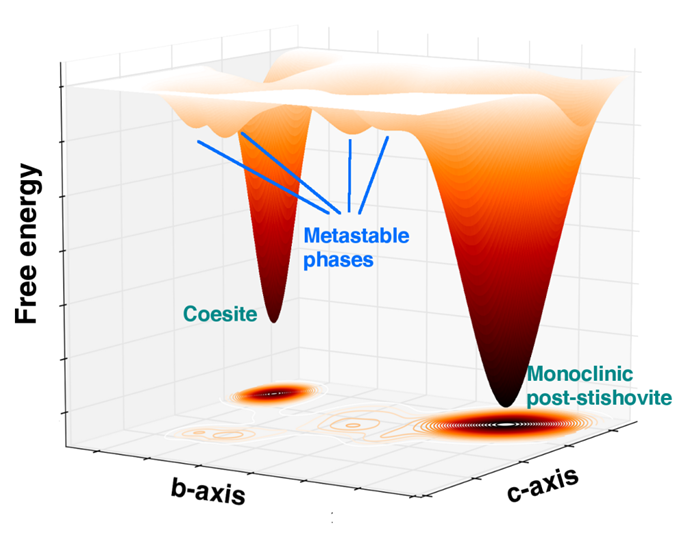Silica: Multiple Phases, other than a glassy structure - Qingyang Hu
MARCH 24, 2015

Using synchrotron x-ray diffraction and theoretical modeling, the team from the Center for High Pressure Science & Technology Advanced Research (HPSTAR) including Qingyang Hu, Wenge Yang, Howard Sheng, and Ho-kwang Mao discovers four previously unknown phases of silicon dioxide, shedding light on the silica compression mechanism at room temperature. Their findings are published by Nature Communications (“Polymorphic phase transition mechanism of compressed coesite,” 6, 6630. DOI: 10.1038/ncomms7630).
Silicon dioxide, also known as silica, is one of the most useful and abundant compounds in nature. Its basic building blocks of silicon-oxygen tetrahedron, which consists of four oxygen atoms at the corners and a central silicon atom, can be arranged in highly ordered arrays to form various crystalline phases such as the minerals quartz and coesite, or arranged randomly to form amorphous phases such as silica glasses. In the Earth’s deep interior, the enormously high pressure and temperature convert the tetrahedra to octahetra with six oxygen atoms surrounding the silicon, and turn quartz and coesite transform to denser crystalline phase such as stishovite. It has long been debated whether five-coordinated silica exists in between the tetrahedra and octahedra. In laboratory, the structure and coordination numbers are measured by x-ray diffraction method. Previous experiments of compressing coesite in laboratory without heating, however, produced broad and featureless x-ray diffraction patterns that were interpreted as pressure-induced amorphous silica.
Hu and his team combined state-of-the-art high-pressure single-crystal x-ray diffraction technique and first-principles theoretical calculation. They discovered that when a single-crystal of coesite was compressed at room temperature from 257,000 to 523,000 times normal atmospheric pressure (26 to 53 gigapascals), it transforms into four new, co-existing crystalline phases before finally recombining into a single phase that is denser than stishovite, sometimes called post-stishovite, which is the team’s fifth newly discovered phase. Those phases have the same chemical composition as silica, but each one has a unique crystal orientation and has a close relationship with the parent coesite crystal. Coincidently but confidently, the four metastable phases were also confirmed in their first-principles molecular dynamics simulations. The calculated energy surface delineated the transition pathway of compressed coesite, where in an on-going phase transition the system can be trapped into four metastable structures, signified by the development of five-coordinated silicon-oxygen polyhedra. Those low-symmetry phases greatly lowered the overall intensity and widened the width of x-ray diffraction peaks, resembling the amorphization phenomenon reported in the literature.
The work pointed out that the amorphous appearance may result from the mixture of the intermediate crystalline phases en route from coesite to post-stishovite . The multiple metastable phases on the transition pathway constitute the true phase transition mechanism from four-, five- to six-coordinated silica. Their results also demonstrated the power of this integrated low-temperature approach to freeze intermediate phases and garner true understanding of the transition mechanism of refractory materials.
The paper’s other authors are J. Shu and Y. Meng of Geophysical Laboratory, Carnegie Institute of Washington and A. Cadien of George Mason University.

Caption: Free-energy landscape showing the transition pathway from coesite to the high pressure post-stishovite. Image courtesy of Qingyang Hu.
![]() Polymorphic phase transition mechanism of compressed coesite
Polymorphic phase transition mechanism of compressed coesite
